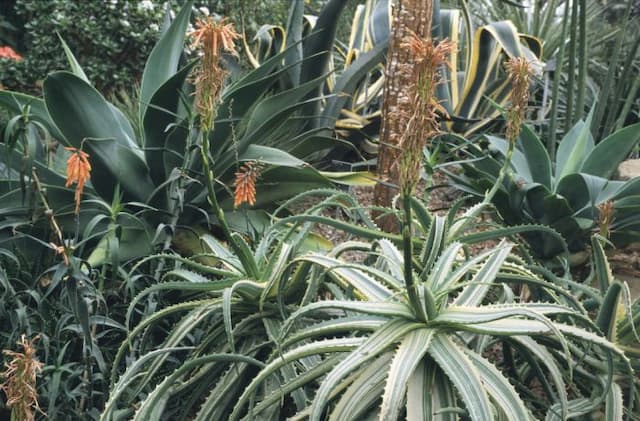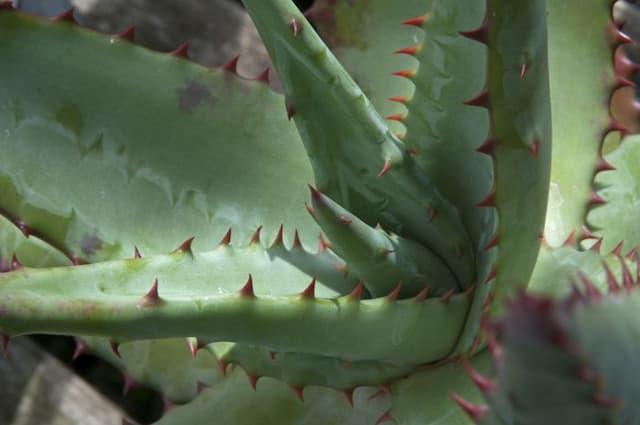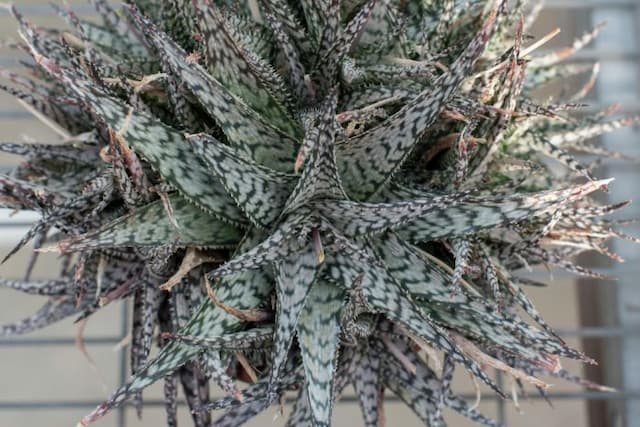Red Hot Poker Kniphofia 'Strawberries and Cream'

ABOUT
Kniphofia 'Strawberries and Cream', commonly known as Red Hot Poker, Torch Lily or Poker Plant, is a striking perennial known for its distinctive flower spikes. The plant features clumps of grass-like, arching, green leaves from which rise the flower spikes. The blooms themselves are tubular and are arranged in dense clusters along the spike. The blossoms transition from a creamy white color at the base, gently blending into shades of pinkish-red, resembling the colors of strawberries and cream. This gradation of white to red provides a visually appealing two-tone effect. The plant typically flowers in summer and can sometimes bloom into fall, offering a long-lasting display. In addition to the striking flower spikes, the evergreen foliage of the Red Hot Poker is narrow and resembles blades of grass. The leaves may bend under their own weight and splay out around the plant base, adding texture and greenery to the garden throughout the year. Red Hot Poker is a favorite among hummingbirds and butterflies, making it an ideal choice for gardeners looking to attract wildlife.
About this plant
 Names
NamesFamily
Asphodelaceae
Synonyms
Red Hot Poker, Torch Lily, Poker Plant
Common names
Kniphofia 'Strawberries and Cream'.
 Toxicity
ToxicityTo humans
Kniphofia 'Strawberries and Cream', commonly known as Red Hot Poker, is not generally considered toxic to humans. However, it is always recommended to be cautious and avoid ingesting plants that are not meant for consumption, as they may cause irritation or an allergic reaction in some individuals. There is limited information on the severe toxicity and symptoms of poisoning from ingesting Red Hot Poker as it is not commonly reported to be a poisonous plant.
To pets
Red Hot Poker is also not widely known to be toxic to pets. While it is always best to prevent pets from eating ornamental plants, as they could potentially cause gastrointestinal upset, there is no specific toxicity associated with pets ingesting Red Hot Poker. As with any non-food plant, if an animal does consume a large quantity, it may experience symptoms such as vomiting or diarrhea due to the plant's fibrous nature, but not due to specific toxic compounds.
 Characteristics
CharacteristicsLife cycle
Perennials
Foliage type
Evergreen
Color of leaves
Green
Flower color
Mixed
Height
2 feet (60 cm)
Spread
2 feet (60 cm)
Plant type
Herb
Hardiness zones
6
Native area
Africa
Benefits
 General Benefits
General Benefits- Attractive flowers: Produces spikes of creamy white to soft pink flowers that add color to the garden.
- Long blooming: Offers a long flowering season from early to late summer, providing visual interest over an extended period.
- Wildlife-friendly: Attracts pollinators such as bees, butterflies, and hummingbirds, supporting local ecosystems.
- Drought tolerance: Once established, it's quite drought resistant, making it suitable for arid climates or water-wise gardens.
- Low maintenance: Requires minimal care once established, making it a good choice for gardeners of all skill levels.
- Versatile planting: Suitable for borders, container planting, and mass plantings, offering flexibility in garden design.
- Deer resistance: Generally resistant to deer, which can help to maintain its beauty in areas with high deer populations.
- Architectural form: Provides vertical interest and texture to gardens with its tall, upright flower spikes.
 Medical Properties
Medical PropertiesThis plant is not used for medical purposes.
 Air-purifying Qualities
Air-purifying QualitiesThis plant is not specifically known for air purifying qualities.
 Other Uses
Other Uses- Textile Dye: The vibrant colors of Red Hot Poker flowers may be used to create natural dyes for fabric, giving textiles a unique and organic hue.
- Photography Subject: Due to its striking appearance, Red Hot Pokers are often used by photographers as a subject for botanical photography, enhancing plant portfolios.
- Craft Projects: The dried seed pods and flower spikes can be incorporated into craft projects such as wreaths or as natural elements in mixed media art.
- Floral Arrangements: Fresh or dried, the flower spikes of Red Hot Poker add dramatic height and color to bouquets and floral arrangements.
- Garden Structure: When not in bloom, the spiky foliage provides structural interest in the garden, enhancing its winter appearance.
- Culinary Garnish: Edible varieties of Red Hot Poker flowers can be used as a colorful garnish to brighten up culinary dishes, though it's uncommon.
- Educational Tool: Red Hot Pokers can be used in educational settings to demonstrate plant growth, pollination, and perennial life cycles to students.
- Marker Plant: Red Hot Pokers can serve as marker plants in the garden, helping gardeners to mark the location of more delicate, lower growing perennials that may be dormant in early spring.
- Frost Indicator: The tips of the foliage can hint at the occurrence of frost, as they're sensitive and may show damage if temperatures drop too low.
- Barrier Planting: Due to its spikey leaves and tall flower stalks, Red Hot Pokers can be planted as barrier plants to discourage pets and wildlife from accessing certain areas of the garden.
Interesting Facts
 Feng Shui
Feng ShuiThe Red Hot Poker is not used in Feng Shui practice.
 Zodiac Sign Compitability
Zodiac Sign CompitabilityThe Red Hot Poker is not used in astrology practice.
 Plant Symbolism
Plant Symbolism- Colorful Personality: Kniphofia, commonly known as "Red Hot Poker" or "Torch Lily", often symbolizes a vibrant and colorful personality, attracting attention much like their striking flower spikes.
- Strength and Endurance: Their robust nature and ability to thrive in hot conditions can represent strength and the capacity to endure challenging environments.
- Stand Out: The distinctive and dramatic appearance of the Red Hot Poker's flowers may symbolize standing out from the crowd and being unique.
- Passion: The fiery colors of the flowers, with reds and oranges, can denote intense emotion and passionate feelings.
- Attraction and Magnetism: Due to its showy flowers, which are magnets for birds and pollinators, it could represent attraction and the power to draw others in.
 Water
WaterThe Red Hot Poker should be watered deeply once every week, allowing soil to dry slightly between waterings. Utilize approximately 1 to 1.5 gallons of water per plant for each watering session to ensure the root zone is thoroughly saturated. In periods of extreme heat or drought, increase watering frequency to maintain consistent moisture, but avoid waterlogging the soil. During winter months or in cooler climates, reduce watering to prevent root rot.
 Light
LightRed Hot Pokers thrive in full sunlight, requiring at least 6 hours of direct sunlight daily. They perform best when placed in a spot that receives morning light and protection from harsh afternoon sun, which helps to prevent scorching of the leaves. However, these plants are quite adaptable and can tolerate a range of light conditions but will bloom less vigorously in partial shade.
 Temperature
TemperatureRed Hot Pokers prefer temperatures between 50 to 85°F and can withstand temperatures down to 20°F, though they should be protected from extreme cold with mulching. They are hardy in USDA zones 5 through 9 and enjoy consistent warmth but can tolerate brief periods of cooler weather. Avoid exposing them to temperatures above 90°F, which can stress the plant.
 Pruning
PruningPruning Red Hot Pokers encourages healthier growth and better flowering. Remove spent flower spikes immediately after bloom to stimulate new flowers. In late winter or early spring, before new growth begins, cut back the foliage to about 3 inches from the ground. Conduct a general cleanup of dead or damaged leaves as needed, typically once or twice a year.
 Cleaning
CleaningAs needed
 Soil
SoilFor Kniphofia 'Strawberries and Cream', commonly known as Red Hot Poker, the best soil mix is well-draining, rich in organic matter with a pH between 6.0 to 6.5. Sand or grit can be added to improve drainage, and a yearly mulch of compost will keep it nutrient-rich.
 Repotting
RepottingRed Hot Pokers should be repotted every 2-3 years to refresh the soil and accommodate growth. The best time to repot is in spring before new growth begins.
 Humidity & Misting
Humidity & MistingRed Hot Pokers, unlike many other plants, are quite tolerant of dry air conditions. They do not require high humidity levels and can thrive in the average outdoor humidity levels found in their growing zones.
 Suitable locations
Suitable locationsIndoor
Provide bright light and good airflow for Red Hot Poker.
Outdoor
Plant in full sun, well-drained soil, and allow for spacing.
Hardiness zone
6-9 USDA
 Life cycle
Life cycleRed Hot Poker 'Strawberries and Cream' begins its life cycle as a seed, germinating in warm, moist soil, typically in late winter or early spring. The seedlings grow into clumps of grass-like foliage, which mature over the course of the growing season. In the second year, or sometimes later in the first year, the perennial plant sends up tall flower spikes bearing tubular flowers that transition from cream to pink to red, resembling a flaming torch. After blooming, which usually happens in summer, the flowers are followed by seed pods if pollinators have been successful. The plant then enters a period of dormancy during the colder months, with the foliage remaining evergreen in milder climates or dying back in colder zones. With proper care, the cycle repeats annually, as the plant can live for several years, growing larger and producing more flower spikes each year.
 Propogation
PropogationPropogation time
Spring-Early Summer
The Red Hot Poker 'Strawberries and Cream' can be propagated through division, which is the most popular method for this perennial plant. It is best to divide the clumps in the spring or early fall to allow sufficient time for the plants to establish before the harsh temperatures of winter or the peak of summer heat. The process involves carefully digging up the established clumps, separating them into smaller clumps while ensuring that each new section has a good amount of roots attached. These new divisions should then be replanted immediately at the same depth they were previously growing, spaced about 18 to 24 inches (approximately 45 to 60 centimeters) apart to allow for ample growth. Water the new plants thoroughly to help establish them. This method not only propagates the plants but also revitalizes older clumps that might have become too dense, helping to maintain the plant's vigor and blooming potential.









